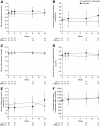Changes in fibroblast growth factor 23 levels in normophosphatemic patients with chronic kidney disease stage 3 treated with lanthanum carbonate: results of the PREFECT study, a phase 2a, double blind, randomized, placebo-controlled trial
- PMID: 24885942
- PMCID: PMC4107721
- DOI: 10.1186/1471-2369-15-71
Changes in fibroblast growth factor 23 levels in normophosphatemic patients with chronic kidney disease stage 3 treated with lanthanum carbonate: results of the PREFECT study, a phase 2a, double blind, randomized, placebo-controlled trial
Abstract
Background: High levels of circulating fibroblast growth factor 23 (FGF23) are associated with chronic kidney disease (CKD) progression and high mortality. In the Phosphate Reduction Evaluation of FGF23 in Early CKD Treatment (PREFECT) study, we assessed the effect of reducing intestinal phosphate absorption using lanthanum carbonate on FGF23 levels in normophosphatemic patients with CKD stage 3.
Methods: Thirty-five individuals were randomized to lanthanum carbonate 3000 mg/day (n=23) or placebo (n=12) for 12 weeks. Levels of intact FGF23 (iFGF23), C-terminal FGF23, serum and urinary phosphate and calcium, intact parathyroid hormone and 1,25-dihydroxyvitamin D were assessed.
Results: The median age was 65 years in the lanthanum group and 73 years in the placebo group; 58.8% and 41.7% were men, respectively. No significant difference was seen in mean iFGF23 between groups at week 12. There was, however, a transient reduction from baseline in iFGF23 in the lanthanum group at week 1, from 70.5 pg/ml to 51.9 pg/ml, which was not seen in the placebo group; this between-group difference in percentage change from baseline was significant in post hoc analyses (p=0.0102). Urinary phosphate decreased after 1 week of lanthanum treatment and remained low at week 12.
Conclusions: Reducing intestinal phosphate absorption with lanthanum carbonate did not lead to sustained reductions in iFGF23 in patients with CKD stage 3, although phosphaturia decreased. This suggests that factors other than phosphate burden may be responsible for driving increases in circulating FGF23 in patients with CKD.
Trial registration: ClinicalTrials.gov NCT01128179, 20 May 2010.
Figures



References
-
- Fliser D, Kollerits B, Neyer U, Ankerst DP, Lhotta K, Lingenhel A, Ritz E, Kronenberg F, Kuen E, Konig P, Kraatz G, Mann JF, Muller GA, Kohler H, Riegler P. Fibroblast growth factor 23 (FGF23) predicts progression of chronic kidney disease: the Mild to Moderate Kidney Disease (MMKD) Study. J Am Soc Nephrol. 2007;18:2600–2608. doi: 10.1681/ASN.2006080936. - DOI - PubMed
-
- Gutierrez OM, Januzzi JL, Isakova T, Laliberte K, Smith K, Collerone G, Sarwar A, Hoffmann U, Coglianese E, Christenson R, Wang TJ, DeFilippi C, Wolf M. Fibroblast growth factor 23 and left ventricular hypertrophy in chronic kidney disease. Circulation. 2009;119:2545–2552. doi: 10.1161/CIRCULATIONAHA.108.844506. - DOI - PMC - PubMed
Publication types
MeSH terms
Substances
Associated data
LinkOut - more resources
Full Text Sources
Other Literature Sources
Medical

